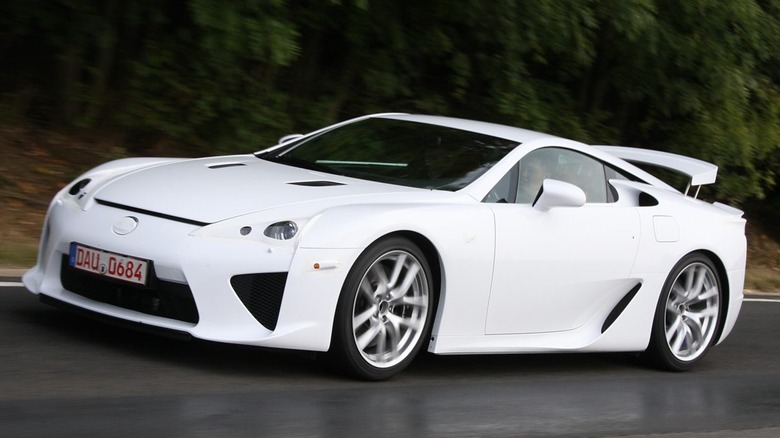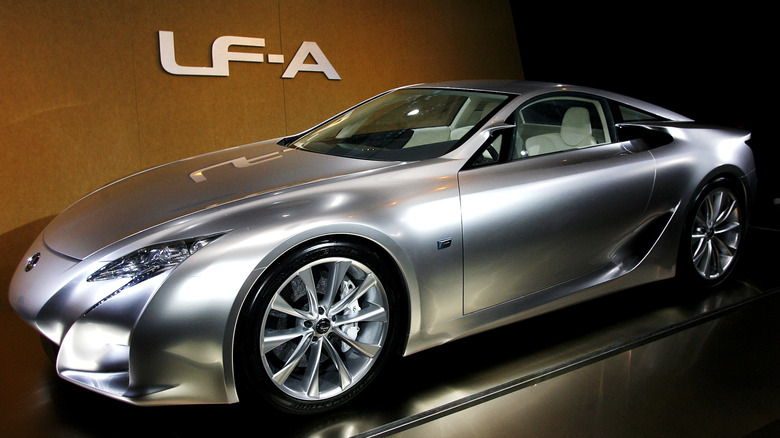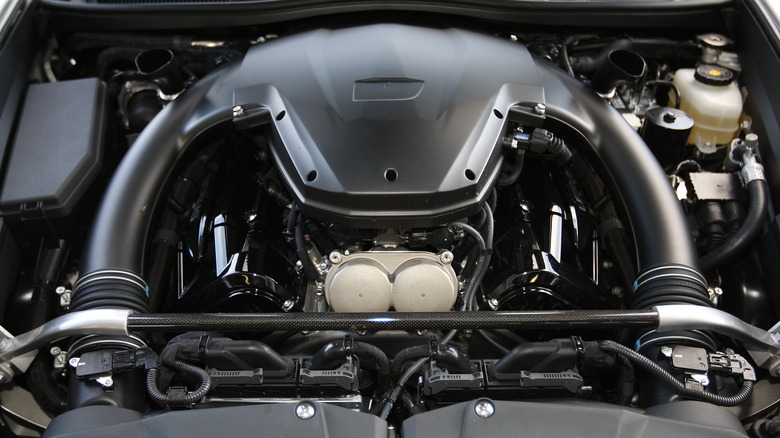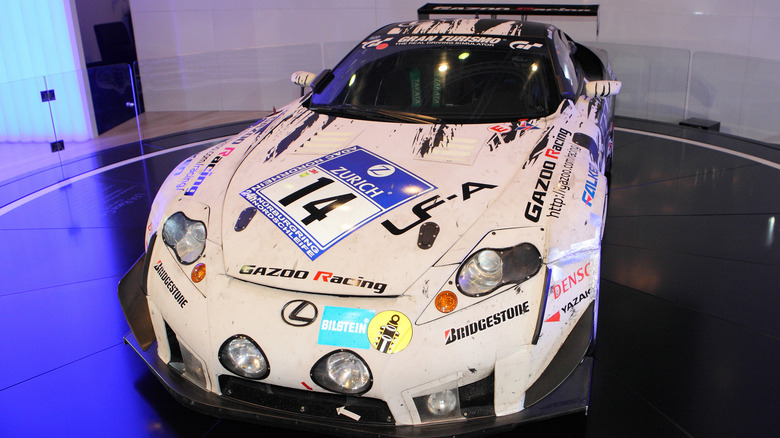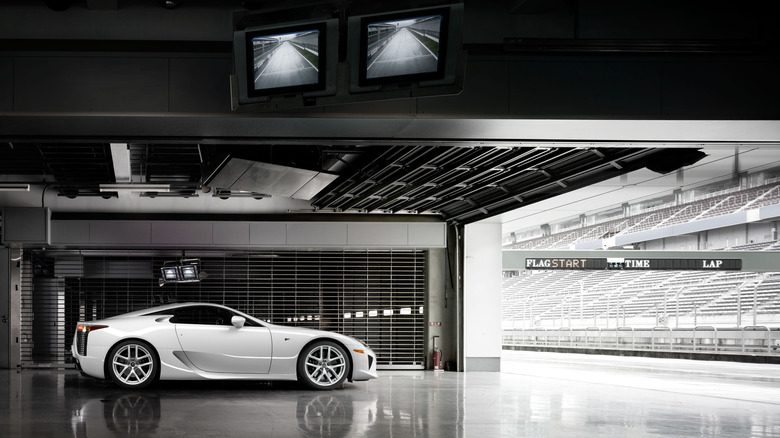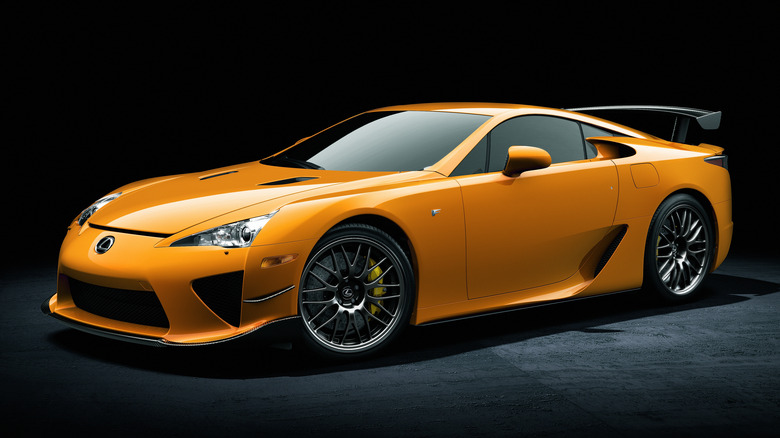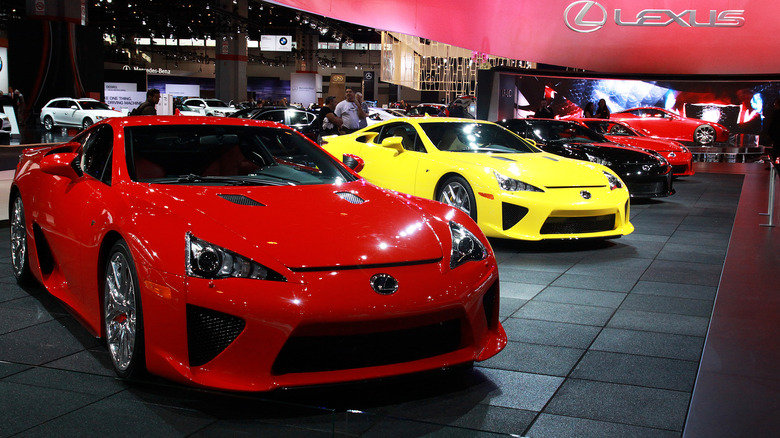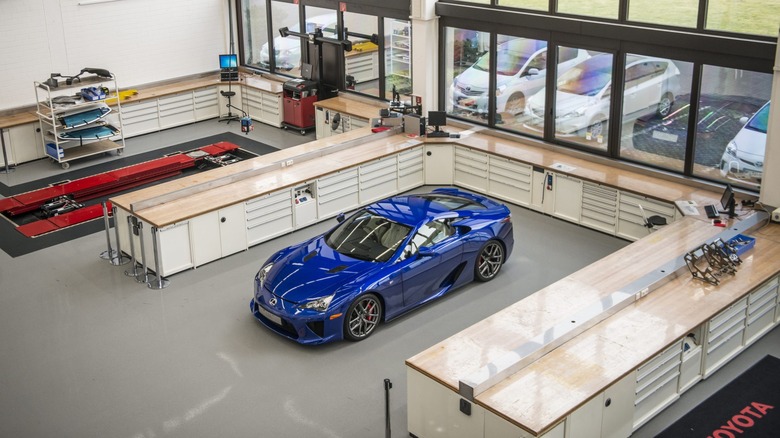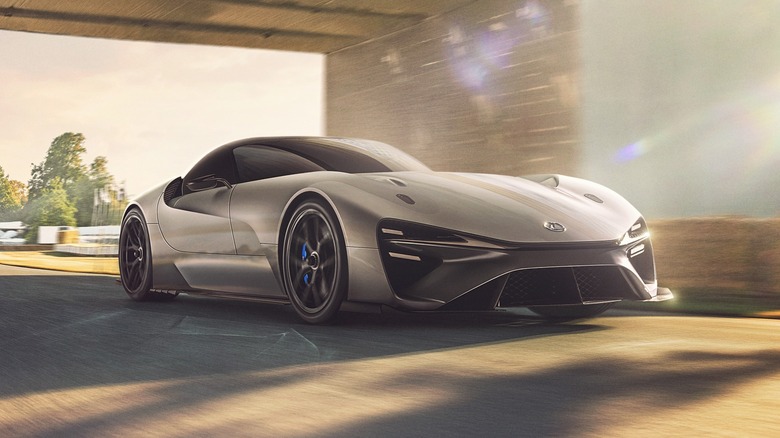Lexus LFA: Everything You Should Know By Now
Making a supercar from scratch is an extremely difficult task –- just ask any of the dozens of ambitious startups that go bust every year. However, the creators of the Lexus LFA faced an even more complex challenge than most. As well as simply creating a great supercar, they had to build something that would serve as a halo product for one of the world's largest automakers, drawing attention to its luxury arm and asserting its place in the modern performance car world. No wonder, then, that it took so long for them to get it right.
With extensive development time and unprecedented amounts of cash poured into the project, the pressure was on to deliver something exceptional. Yet, the small core team of engineers and designers on the project pulled through, creating something unlike any other Toyota or any Japanese car before it. The LFA wasn't universally celebrated at launch, but in the years since then, it's cemented itself as one of the very best supercars of its era — no mean feat for an idea that started its life as a drawing on the back of a napkin.
A long shot
The unlikely origins of the LFA can be traced back to a small group of engineers working at Toyota's testing ground in north Japan. Among the team was Haruhiko Tanahashi, who proposed the idea of a Toyota supercar that could be developed at the facility. After sketching out some initial designs on a set of nearby napkins, Tanahashi and his team started preliminary research in early 2000. The following year, he showed his work to Hiromu Naruse, Toyota's chief test driver at the time. The pair further developed the initial designs and brought Akio Toyoda — the grandson of Toyota's founder — onto the project in 2002.
Despite his relatively junior role in the company at the time, it was Toyoda who was key in getting the project approved by Toyota bosses. Initially, the idea was met with heavy resistance from the board, primarily because of the costs involved. It was almost certain to be a loss-making car, but Toyoda's persistence eventually won over executives. Despite being unlike any car Toyota had ever created before and requiring the development of entirely new processes and facilities, the LFA project was given the green light.
No compromises in development
The first prototype was completed in 2003, but it took a further year for the car to begin testing on the track. From the start, it was decided that the Nürburgring Nordschleife would be an important development ground for the car, alongside Toyota's own proving ground in Japan. Initial tests were completed and in 2005, the first LF-A concept was publicly shown off at the Detroit auto show. Its V10 engine and striking all-aluminum construction caused a stir among the press, but it was far from a finished product.
In fact, a last-minute decision by the team to switch from an aluminum chassis to one made from carbon fiber reinforced plastic nearly derailed the whole project. It pushed development time back even further since the production plant had never worked with the material before and caused what was already a significantly delayed vehicle to fall even more behind schedule.
Also complicating matters was the development of the all-new V10 engine for the car. It was built in collaboration with Yamaha and boasted an 8,700 rpm redline, yet it needed to be just as reliable as any other Lexus engine. At launch, the engine was rated at 553 horsepower, making it by far the most powerful unit that Toyota had ever put in a road car.
Toyoda's determination to race
The LFA's engine, like nearly all of its other components, was developed first and foremost on the track. Alongside his passion for the supercar project, Akio Toyoda was a keen racing driver and decided to enter the 24 Hours of Nürburgring in 2007. Like before, Toyoda's efforts were met with heavy skepticism from other Toyota executives -– by this point, he was Executive Vice President of the automaker, and fellow execs simply couldn't understand why he wanted to go racing. As a result, Toyoda was barred from using the Toyota name for his race team, so he chose to adopt the moniker Gazoo Racing.
With very little financial help from the carmaker, Toyoda mostly funded the team himself and chose to enter the race under the pseudonym Morizo to avoid attracting unwanted attention and risking further backlash. While the team's initial race results were mixed, Toyoda and his development team used the experience to feed back into the development of the LFA. In 2008, the team entered a prototype LFA into the Nürburgring race, further helping to hone the performance of the forthcoming road car.
Launch and the loss of Naruse
In October 2009, the LFA was officially launched in roadgoing form after nine long years of development. A total of 500 units would be built, with production commencing in late 2010. However, a few months before the start of production, one of the team's key members would be sadly lost. Test driver Hiromu Naruse, one of the earliest proponents of the project and a key figure throughout its development, was involved in a fatal accident on a public road near the Nürburgring.
He was driving a pre-production LFA when he collided with a BMW in the opposite lane. While the BMW's occupants survived, Naruse was pronounced dead at the scene. The following months were an extremely difficult period for both the team and the LFA project as a whole. However, keen to honor Naruse's memory, road car production continued as planned in 2010, and Gazoo Racing continued to race the car in competition.
The Nürburgring special
Just a few months before the LFA's initial launch, Toyoda was appointed the president of Toyota and had ultimate responsibility over all of the brand's products. It was a baptism of fire, as his first year in the role was marked by the announcement of the brand's first annual loss in decades due to the global recession, and he faced scrutiny over a major recall of Toyota cars in America. Even throughout the chaos, the president remained keen to develop the LFA further, approving a limited run of 50 LFA Nürburgring Package special editions to be built at the end of the car's production.
The special edition featured a bump in power over the standard LFA, producing 563 horsepower, with a new front spoiler and rear wing for added aero efficiency. The suspension was also tweaked for optimal circuit handling. The Nürburgring Package quickly proved its track supremacy by setting a lap time of 7:14.64 at the hands of Toyota test driver Akira Iida. At the time, it was the fastest time a production car had ever set, and it was achieved using the LFA's regular Bridgestone tires.
The racing variant of the car also saw success on the track, winning its class at the 24 hour race twice in 2011 and 2012. The vehicle was continually developed over its competition life, a fact neatly demonstrated by the 2012 car's fastest lap being a full 11 seconds faster than the previous year's car.
A mostly positive critical reception
With so many delays to the LFA project, the automotive landscape had changed significantly in the time between its conception and its eventual delivery to customers. It would take until December 2012 for the final example to roll off the production line –- Lexus' commitment to hand-building the car meant that production was limited to just a single unit per day. At the same time, its Lexus badge drew inevitable comparisons to other Toyota cars from the media. A light-hearted comparison of the LFA to a Camry or Cressida might have made for good reading, but it undersold the capabilities of the car.
That said, the LFA wasn't without its flaws. Some critics found its custom-designed single-clutch transmission to be less impressive than other supercars with dual-clutch setups, and its $375,000 starting price drew plenty of criticism. This was, after all, a Lexus that cost more than a limited-edition Ferrari.
The general impression among both reviewers and buyers, however, was that Lexus had pulled it off. It might have arrived later than planned, but the LFA still boasted performance that could match the most capable cars of the day and was extremely enjoyable to drive. Not to mention, the sound of its V10 was in a league of its own even compared to the most exciting special editions that Ferrari or Porsche could offer.
A lasting legacy
Time has been kind to the LFA, and it's now regarded by many as one of the best supercars of its era. It's also become increasingly apparent just how important the car's development was for Toyota's motorsports history –- without it, the now-factory backed Gazoo Racing team and road going GR Supra and GR Yaris might never have been conceived. It's also become clear that the LFA is truly a one-of-a-kind car in more ways than one. As Toyota and the automotive industry begin the switch to electrification, it seems almost certain that any future halo car won't feature the LFA's symphonic V10.
Prices for the LFA have slowly but surely risen in recent years as collectors have come to realize the importance of the car. As recently as 2020, it was possible to buy an LFA for less than $500,000, but throughout 2023, the average auction price for standard editions of the car hovered around $700,000.
There have been reports of unsold LFAs hanging around dealerships for years after the initial production run ended, which has led to some claims that the cars were simply unwanted. However, a 2017 investigation by Jalopnik found that many were instead being held onto by dealerships, who were keen to keep their unregistered cars as showpieces rather than sell them off to private collectors. Other dealers were simply waiting until prices for the car reached high enough above the original MSRP before considering selling.
The LFA's successor
The dealers keeping hold of the LFA as a unique showpiece are still waiting for a successor, but it seems likely that one will eventually appear. Akio Toyoda has previously compared Toyota's halo projects to the rebuilding of the Ise Shrine in Japan -– every 20 years, the shrine is rebuilt to ensure that the building techniques are always passed on to the next generation. Toyoda sees the Japanese automaker's previous projects as carving a similar legacy. In the '60s, the 2000GT proved that Toyota could build a true sports car, and in the '80s, the development of the Supra saw that sports car expertise taken to new heights.
The LFA's delays meant the project arrived later than the 20 year goal, but Toyoda stated that the plan is to wait a further two decades before unveiling the next project. The Lexus Electrified Sport concept unveiled in 2022 dropped a heavy hint at the successor's styling, but further details on a future halo car are scarce. In 2021, Toyoda claimed an all-electric halo sports car was indeed in the works, saying that it borrowed the LFA's "secret sauce" but did not reveal a timeline for when such a vehicle would make a public appearance.
If his previously stated goal of a new halo project every 20 years is anything to go by, it seems that the LFA's successor won't break cover until the latter half of this decade at the earliest.
